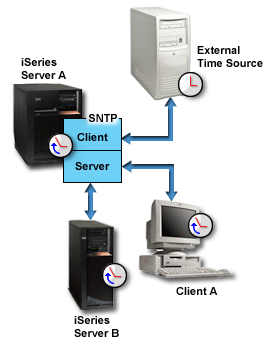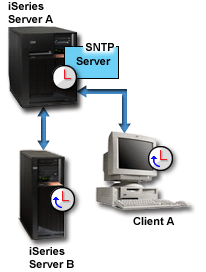Use this information to learn how a typical time maintenance application works. You can also view an example environment that uses Simple Network Time Protocol (SNTP) as a time maintenance application.
A time maintenance application maintains the system time with an external time source. Each time maintenance application is unique and is programmed differently. However, the overall purpose of a time maintenance application is to retrieve a time value from an external time source and compare it to the system's time value. If the two values differ, a time adjustment begins. The amount of time that the two values must differ before a time adjustment begins is unique to the actual time maintenance application that you are using.
Use the time adjustment (QTIMADJ) system value to identify the software to use to adjust the system clock to keep it synchronized with an external time source. The system does not enforce the software specified; it only identifies the software to use. This value should be maintained by the time adjustment software and is intended as an aid to prevent having multiple time adjustment applications conflict with each other. The system does not verify this value or that this software is or is not performing time adjustments. IBM® time adjustment offerings use identifiers that start with QIBM such as QIBM_OS400_SNTP. Other software suppliers should follow a similar naming convention of company name and product name.
Time adjustment software should check this system value before starting. If this system value has an identifier for other time adjustment software, then the software being started should notify the user of this potential conflict and confirm that this time adjustment software should be started. When there is no identifier associated with this system value, the software should update this system value to identify that it is now responsible for adjusting the system clock. Time adjustment software should check this system value again before ending. This system value should be set to 'None' only if the current value identifies this time adjustment software that is ending.
You can use the SNTP application to maintain your system time. The SNTP application is an IBM-supplied time maintenance application that you can use as a client, server, or both.
In Figure 1, the iSeries™ server (Server A) uses the SNTP application as a client and a server. The SNTP client retrieves a time value from an external time source. The external time source is determined by what you specify to use. The SNTP application synchronizes Server A's coordinated universal time (UTC) with the time value from the external time source. Then, the SNTP server (Server A) sends the time value to all SNTP client systems (iSeries Server B and Client A) connected to it.
In Figure 2, the iSeries Server A uses the SNTP server. In this situation, the UTC time is retrieved from the iSeries server rather than being synchronized with an external time source. This internal time value is sent to all SNTP client systems (iSeries Server B and Client A) connected to it.

